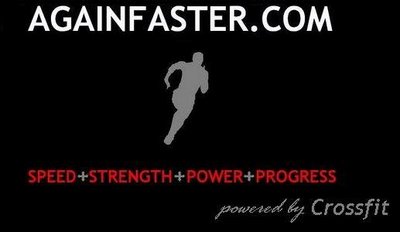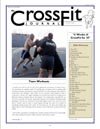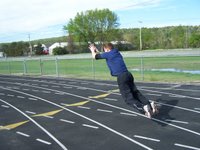Caught Flat-Footed

Last night, I was watching the World Class Coaching DVD on the clean. I made it through the first hour before I had to shut it off.
My brain couldn’t assimilate the wealth of knowledge contained in the first sixty minutes of the video, let alone the following forty. Watching Shane Hamman clean four hundred pounds with the same dexterity as a ten-pound training bar was absolutely surreal. Cut-aways to Pyrros Dimas and Marc Huster at the 1991 World Championships only added to the effect.
Then the real bombshell. About twenty-five minutes in, the narrator said something like this:
“It is our opinion that the ankles should not extend during the second pull. Despite the fact that many world-class athletes employ ankle extension, we don’t believe it embodies the most efficient technique. Rising up on the toes shifts the center of gravity forward, making the clean more difficult. As the clean is refined, and heavier weights are lifted, we believe this movement will be discarded.”
Holy sh*t. What did he just say?
The video cut back to Hamman, throwing around four hundred pounds like he was warming up for jog in the park. Sure enough, the soles of his shoes remained parallel to the platform for the entire lift. Suddenly back at the World Championships, my eyes were glued to Dimas’ feet. Not a hint of ankle extension.
Watch Hamman at The 2000 North America, Central America and Caribbean Islands Weightlifting Championships:
The evidence was right there in front of me. The best lifters on the Planet employ a double-extension technique. The knees and hips extend, with the ankles continually dorsiflexed at ninety degrees.
The narrator didn’t do me the favor of explaining further, and I was left to rationalize this one on my own.
My bewilderment cleared up as I thought back to my USA Track and Field certification. The O-lifters were keeping their ankles rigid, much like sprinters and high jumpers. These track athletes maintain dorsiflexion because force transmission is compromised if the ankle is extended, and sprinting and jumping at an elite level requires maximal force transmission. They cannot afford a weak link.
Our Olympic lifters are doing the same thing. Any shock absorbing link between the platform and the barbell will compromise the amount of force the athlete can put on the bar, thereby limiting the amount of weight he can clean. Flexing the ankle to ninety degrees maximizes force transmission.
Coming up on the toes compromises another important attribute—balance. This action shifts the center of gravity forward and upward, away from the desired direction of travel. The bar path for a properly executed clean is upward and backward, with about four inches of rearward horizontal displacement. Any forward displacement of the body could compromise the athlete’s ability to rack the bar, as it would cause the barbell to move forward rather than backward.
I’ve had trouble with this myself, my cleans landing forward of their optimal racking position. Lincoln Brigham, a USA Weightlifting Coach out of Sedona, Arizona, theorized that my second pull wasn’t close enough to my body, and my elbow whip wasn’t fast enough, causing me to rack too far behind the bar.
Although these observations are undoubtedly true, I now believe that my extreme ankle extension is exacerbating the problem.
Fighting ankle extension is difficult, and requires an acute awareness of body position throughout the lift. Nonetheless, I've witnessed it in action with my own eyes, so it can't be sworn off as impossible. From this day forward, I’m abandoning triple extension in favor of a flat-footed approach to the clean.
If it's good enough for Shane, it's good enough for me.
Go faster!
Hamman profile picture courtesy of realsolutionsmag.com. Video of Hamman at the 2000 North America, Central America and Caribbean Islands Weightlifting Championships courtesy of Ticket2Sports.com via YouTube.

Last night, I was watching the World Class Coaching DVD on the clean. I made it through the first hour before I had to shut it off.
My brain couldn’t assimilate the wealth of knowledge contained in the first sixty minutes of the video, let alone the following forty. Watching Shane Hamman clean four hundred pounds with the same dexterity as a ten-pound training bar was absolutely surreal. Cut-aways to Pyrros Dimas and Marc Huster at the 1991 World Championships only added to the effect.
Then the real bombshell. About twenty-five minutes in, the narrator said something like this:
“It is our opinion that the ankles should not extend during the second pull. Despite the fact that many world-class athletes employ ankle extension, we don’t believe it embodies the most efficient technique. Rising up on the toes shifts the center of gravity forward, making the clean more difficult. As the clean is refined, and heavier weights are lifted, we believe this movement will be discarded.”
Holy sh*t. What did he just say?
The video cut back to Hamman, throwing around four hundred pounds like he was warming up for jog in the park. Sure enough, the soles of his shoes remained parallel to the platform for the entire lift. Suddenly back at the World Championships, my eyes were glued to Dimas’ feet. Not a hint of ankle extension.
Watch Hamman at The 2000 North America, Central America and Caribbean Islands Weightlifting Championships:
The evidence was right there in front of me. The best lifters on the Planet employ a double-extension technique. The knees and hips extend, with the ankles continually dorsiflexed at ninety degrees.
The narrator didn’t do me the favor of explaining further, and I was left to rationalize this one on my own.
My bewilderment cleared up as I thought back to my USA Track and Field certification. The O-lifters were keeping their ankles rigid, much like sprinters and high jumpers. These track athletes maintain dorsiflexion because force transmission is compromised if the ankle is extended, and sprinting and jumping at an elite level requires maximal force transmission. They cannot afford a weak link.
Our Olympic lifters are doing the same thing. Any shock absorbing link between the platform and the barbell will compromise the amount of force the athlete can put on the bar, thereby limiting the amount of weight he can clean. Flexing the ankle to ninety degrees maximizes force transmission.
Coming up on the toes compromises another important attribute—balance. This action shifts the center of gravity forward and upward, away from the desired direction of travel. The bar path for a properly executed clean is upward and backward, with about four inches of rearward horizontal displacement. Any forward displacement of the body could compromise the athlete’s ability to rack the bar, as it would cause the barbell to move forward rather than backward.
I’ve had trouble with this myself, my cleans landing forward of their optimal racking position. Lincoln Brigham, a USA Weightlifting Coach out of Sedona, Arizona, theorized that my second pull wasn’t close enough to my body, and my elbow whip wasn’t fast enough, causing me to rack too far behind the bar.
Although these observations are undoubtedly true, I now believe that my extreme ankle extension is exacerbating the problem.
Fighting ankle extension is difficult, and requires an acute awareness of body position throughout the lift. Nonetheless, I've witnessed it in action with my own eyes, so it can't be sworn off as impossible. From this day forward, I’m abandoning triple extension in favor of a flat-footed approach to the clean.
If it's good enough for Shane, it's good enough for me.
Go faster!
Hamman profile picture courtesy of realsolutionsmag.com. Video of Hamman at the 2000 North America, Central America and Caribbean Islands Weightlifting Championships courtesy of Ticket2Sports.com via YouTube.




















1 Comments:
Jon, good observation. More interesting to me, however, was the fact that you said you were watching a DVD from World Class Coaching?!? The last time I looked I could only find a VHS tape, and I no longer have a VHS player. Would you mind letting me know about this?
Post a Comment
<< Home